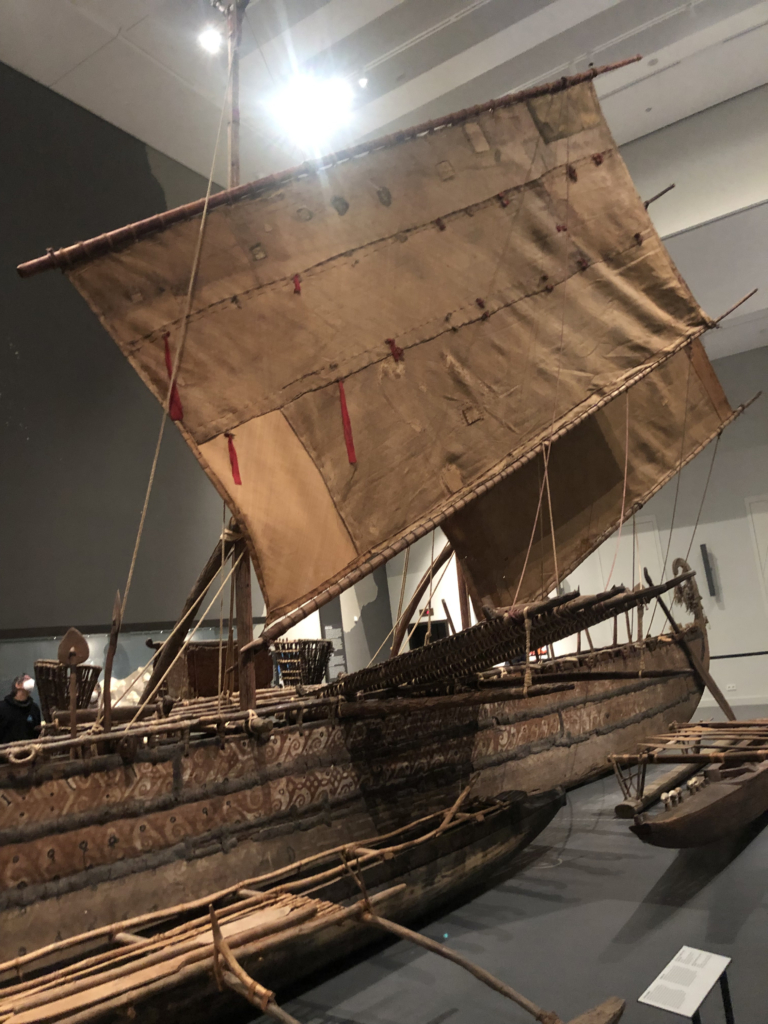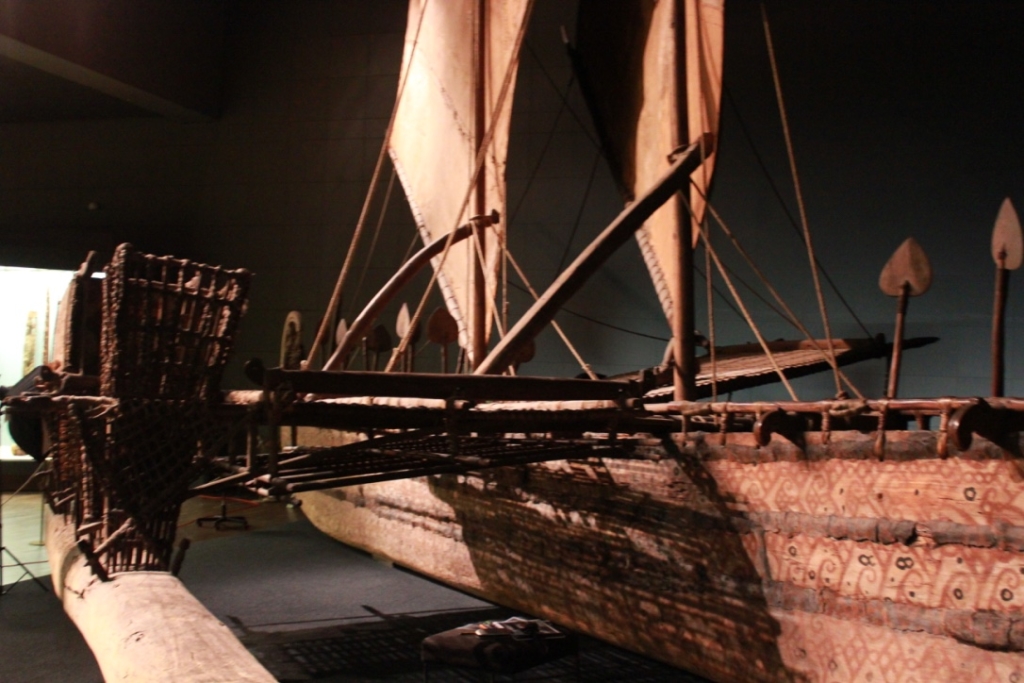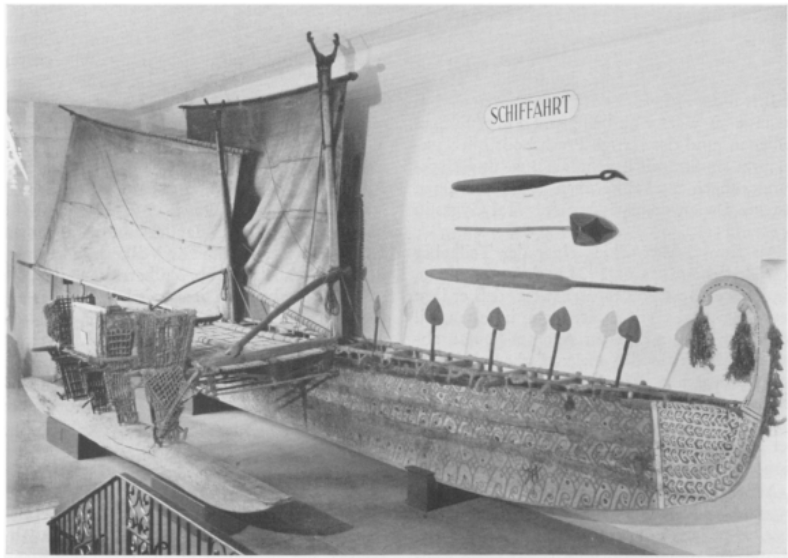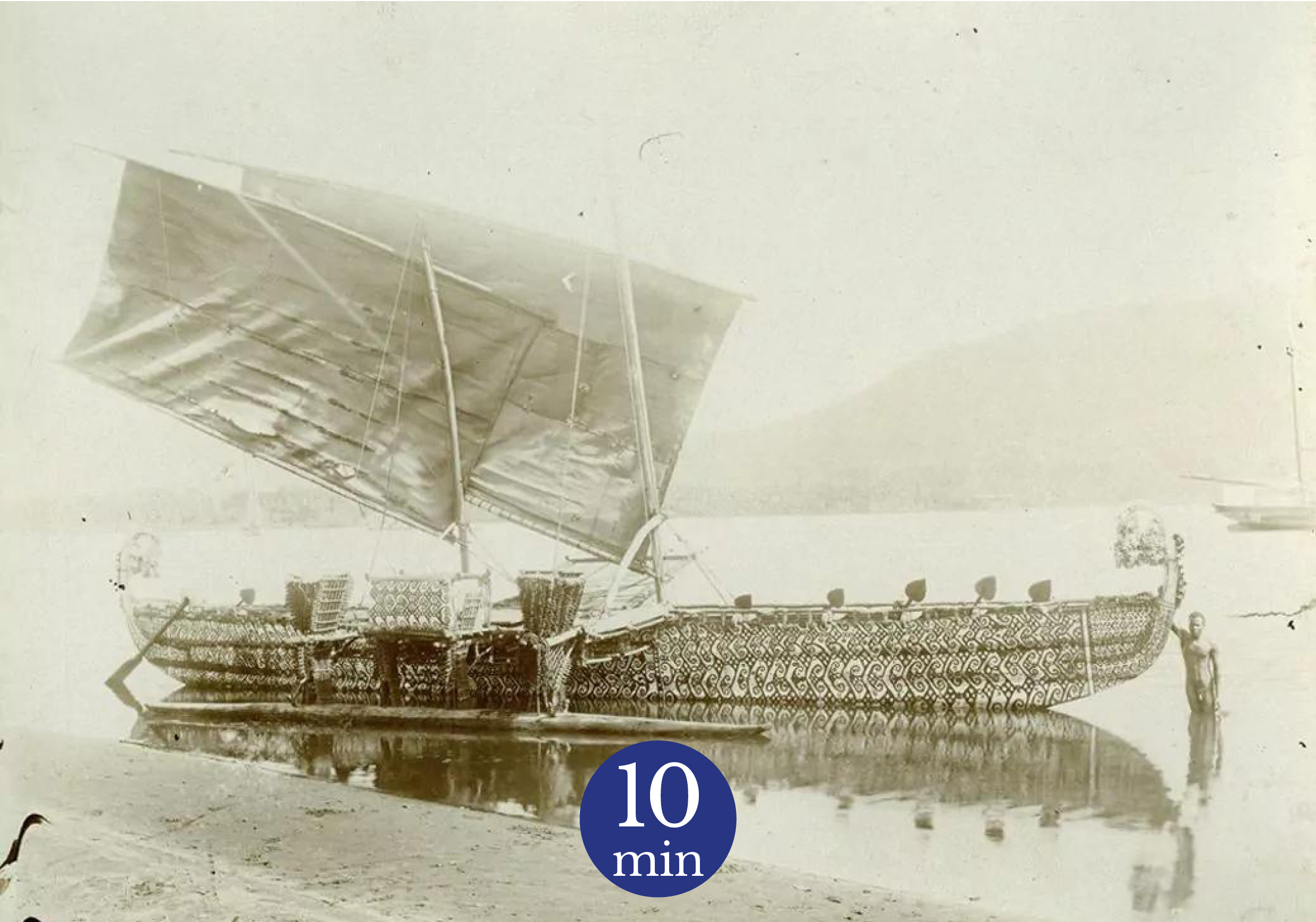November 2022: Visit to the Humboldt Forum. All the rooms of the Ethnological Museum are now open (or almost).1 This is an opportunity to see the great masterpieces of the Pacific collections back on display: dugout canoes and houses have each their own room on two floors, which allows the objects to fully displayed. In the room devoted to houses, a Palau (Palau) meeting house and an Abelam (Papua New Guinea) ceremonial house with a particularly impressive façade take most of the room. Both are presented in such a way that the visitor can see both the exterior and the interior, with the possibility of entering the former. In the room on the Pacific Ocean and navigation, a new Fijian canoe by Joji Marau Misaele and Rogosava Biuwale, a contemporary replica of a 1913 model,2 takes place alongside the pirogue from Luf, an island in the Hermit group of islands in the Bismarck Archipelago of Papua New Guinea. This outrigger canoe, over 15 metres long, is the last remaining example of the technical mastery of large boat construction in the archipelago. Made from a single large tree trunk, the various planks and elements are assembled with rattan, coconut fibre and vegetable mastic, making the boat particularly robust and waterproof.
Next day: visit of the exhibition YOYI! Care, Repair, Heal at the Gropius Bau, curated by – among others – the artists Brook Andrew and Kader Attia. Attia presents a new installation Untitled in which he continues his exploration of the notion of repair. Through interviews with two psychoanalysts, he questions the legacies of collective trauma.3 The psychoanalyst, Karima Lazali, discusses the psychological impact of French colonisation in Algeria and Hannes Uhlemann, a psychotherapist, addresses the psychological consequences of Soviet Germany and the German reunification. These talks are particularly interesting and relevant when Uhlemann mentions the former Palace of the Republic and the reconstruction in its place of the former Prussian Hohenzollern Palace, now the Humboldt Forum. He asks the question of the future of this building: what will happen to it? What does the reconstruction of this palace mean for the collective memory still marked by the trauma of this part of German history? Hannes Uhlemann links this discussion to the question of restitutions and takes the example of the Luf boat. Once emptied of its artefacts, the museum would no longer be necessary and would have to be returned to the former inhabitants of Soviet Germany in order to repair and heal collective memory.

Current presentation of the Luf boat in the Humboldt Forum, November 2022 © Enzo Hamel
This visit to Berlin shows that there is certain anxiety and tension surrounding the Humboldt Forum, particularly regarding restitutions. At the core of the controversy, the Luf canoe is particularly in the spotlight: the German and international press are taking over on the subject and questioning its place in the Berlin collections. The boat and its colonial history also inspire new works of literature, such as Volker Braun's poems Luf Passion by Volker Braun,4 and artistic, such as the installation PARALLEL ARTIFACTS: LUF BOAT d’Adam Harvey.5
The boat arrived in Berlin's collections in 1904, was exhibited intermittently from 1908 onwards, and has been on permanent display since 1970.6 So why is it only now making news?
A new chapter in the history of this Luf dugout opened on the night of May 28th, 2018. In its transport case, the boat travelled for two hours across the city of Berlin before reaching the Humboldt Forum, which was then in the final phase of its construction. A wall left open allowed the boat and the other convoys that followed to enter. Luf boat was the first of a long list of objects to reach the new museum, which was conceived as a space for discussions about non-Western collections.7
May 2021: the wall has been closed, and the museum and its members are making the final preparations for the opening in Autumn 2021. Six months before the opening, Götz Aly, a German historian who has worked mainly on the Nazi regime and anti-Semitism, published his book Das Prachtboot : Wie Deutsche die Kunstschätze der Südsee raubten (A Magnificent Ship: How the Germans Plundered the Cultural Treasures of the South Seas). Le livre fait l’effet d’une bombe dans les médias allemands puis internationaux. The Times quickly published an article on the book. Aly shows that the presence of the boat, the first object to enter the Humboldt Forum, is questioned. The historian points to the colonial history and the violence perpetrated during the colonisation of the Pacific and the establishment of the South Seas colonies.8
In the eye of the storm: histories of colonisation and collection in Luf
In the 1870s and 1880s, the Hermit Islands and their inhabitants suffered from the arrival of Westerners and, in particular, from numerous kidnappings of men to enslave them in different Pacific plantations (a practice known as blackbirding).9 They also suffered from several epidemics, caused by diseases brought by Westerners, natural disasters and 'punitive expeditions' led by the Germans (we are here talking about murders, destruction and/or confiscation of properties etc.) The population of the island of Luf then declined sharply.
The large dugout canoes, such as the one now in Berlin, were destroyed by the Westerners, but one last boat was built in the 1890s. It remained on the island until 1903 when it was transported to Matupi, New Britain, by Maximilian Thiel, director of the colonial trading company Hernsheim & Co. The boat was then sent to Germany where it was finally purchased by the Berlin Ethnological Museum in 1904 for 6,000 marks. The issue is that there is no proof of purchase or transaction between the people of Luf and Maximilian Thiel. Without proof and with knowledge of the particularly violent colonial context, Aly concludes that the boat was stolen by the Germans. According to the author, the very presence of this boat in this new museum becomes unbearable.10
The question of the object's status in German collections quickly became the main concern in the German press. What is to be done with an object acquired under such circumstances? This discussion is particularly influenced by the latest German and international museum news on restitutions. Aly, like others before him, is said to have exposed the cover-ups and lies of the world of ethnographic museums. He drew a connection between the possible restitution of the boat and the case of restitutions of properties looted by the Nazis. As in the case of Nazi looting, collections should be returned or officially purchased (with monetary compensation) at a fair price from the heirs.11

Former presentation of the Luf boat at the Ethnological Museum in Berlin-Dahlem, June 2015 © Clémentine Débrosse
The Prussian Cultural Heritage Foundation, responsible for the management of national museums and collections, tells the Süddeutsche Zeitung that the boat will still be on display but presented as "a memorial to the horrors of the German colonial era."12
The German academic community has also taken up the debate. In Die Zeit, the anthropologist Brigitta Hauser-Schäublin responds to Aly's conclusions. Using her knowledge of Pacific collections and her fieldwork's experience in Papua New Guinea, she counter-argues several elements of Aly's version of the story. Her main criticism is his particularly romanticised view of the islanders. He portrays them as victims without any possibility of action or influence on the local colonial situation, depriving them of any agency. Moreover, Aly has a particularly European-centred view on local cultures. 13
Hauser-Schäublin raises another important point about the acquisition of the boat in Luf. Aly argues that the purchase of the boat can only be fair and equitable through monetary compensation. This raises the question of local notions of value. Aly's argument is based on a notion of value defined primarily by money. The inhabitants are indeed not paid with money but with what Aly describes as 'worthless objects': axes, knives, coloured cloth, tobacco, etc. It is true that if one reflects on the purchase price of the boat by the Berlin Museum (6,000 marks) from Hernsheim & Co, this is a considerable amount. But what would the islanders of Luf do with Deutsche Mark? European cloth seems to have been much more valuable to them at the time. Hellwig describes how the remains of a chief were covered with a large red European cloth and were accompanied by numerous European objects (axes, knives, beads, tobacco, pipes, matches).
Hauser-Schäublin also raises other limits to Aly's reflection and his version of the story on this boat. The first limit concerns the history of its construction. Contrary to his assertion, the boat now preserved in Berlin was not the only one built after the German punitive expeditions. Four other boats were built and launched in 1889 to make a trip to Ninigo, but were caught in a storm and none of them returned to Luf. Construction of the example in the Humboldt Forum began in the early 1890s under the direction of Chief Labenan. Germans, such as the anthropologist Otto Dempwolff, who were present on the islands, mention that Labenan died in 1895 when the boat had just received the last ornaments. The islanders then thought of using it as a burial for Labenan. However, the boat remained on land until 1903 due to a lack of men to launch it. Labenan was eventually buried in the boathouse as was also customary.14
Before Thiel went to the island, the bow and stern ornaments were taken away by a naval officer to be sold to German museums. Thiel then asked Luf men to carve them so that the ship would be complete. They agreed to recreate these ornaments and also built a model of the dugout canoe to offer to Thiel. In this context, the theory of a looting presented by Aly becomes more nuanced. As this event shows, the relationship between colonial representatives and Indigenous people is much more complex than what Aly suggests.

Former display of the Luf boat in the navigation exhibition at the Bruno-Paul-Bau Ethnological Museum in Berlin-Dahlem, 1949-1955 © Staatlichen Museen zu Berlin - Preußischer Kulturbesitz, Ethnologisches Museum/Nevermann 1954: 37.
The story becomes even more complex when Augustin Krämer visits the island in 1906. He spoke to craftsmen who had worked on the construction of the pirogue and obtained a great deal of information about the construction methods and ornaments.15 If the boat had been stolen, would the inhabitants of Luf not have avoided Krämer's questions or remained evasive or even mentioned the theft?
One of the pieces of evidence that Aly considers as proof of the spoliation of the boat comes from an extract from the memoirs of Eduard Hernsheim, former director of the trading company, Hernsheim & Co, for which Thiel worked and which he ended up directing. In this excerpt, Hernsheim mentions that the ship "passed through his hands." According to Aly, this phrasing could not describe an actual purchase.16 However, as the specialist in German colonial history in the region, Jakob Anderhand, shows, Hernsheim was no longer living in the Pacific but in Germany at the time the ship was collected. It was he who received the boat sent by Thiel and arranged the sale for the Berlin museum. The fact that the boat 'passed through his hands' would then simply describe his role as intermediary but not that he was ever the owner of the boat.17
What can we learn from this?
Aly's book has the merit of shedding new light on the German colonial history in the Pacific, but his argument needs to be nuanced in relation to the points made above. German colonisation had terrible consequences for the cultures and peoples of the region. Colonial violence and the asymmetry of power between settlers and colonised peoples must be considered in the ongoing discussions about the future of museums and their collections. It is important, however, not to fall into the trap of an overly simple and dichotomous view of perpetrators and victims, as the reality is often much more complex.
While conversations about the violent history of colonialism, the question of so-called ethnographic collections and museums have so far focused particularly on Africa - especially following the Savoy-Sar report - Aly's publication has opened up discussions about Germany's colonial past in other parts of the world. The author's findings show that the birth and development of imperialism and ethnography, which perpetuated many racialist theories and violence, are inextricably linked to museums and their colonial collections. These issues have been discussed for several decades in academic circles but are now coming to the forefront of public and media attention. Through the story of the Luf boat, German citizens are confronted with their own colonial history and its contemporary legacy. This anxiety about the future of the so-called ethnographic collections and museums could explain the media attention given to the story of the Luf boat. Being confronted with this national history provokes a kind of guilt, to which some Germans seem to want to respond by returning the collections to their country of origin.18
But do the islanders of Luf want this boat back? Where would it be sent? To the island of Luf? To Papua New Guinea's National Museum and Art Gallery in Port Moresby? While many are calling for the return of the boat, very few are discussing the practicalities of its return. For Aly, the museum in Port Moresby which is holding at the moment only replicas, should take back the collections held in Germany.19 The Papua New Guinean Honorary Consul in Germany reacted to Aly's publication: "We have a clear attitude: everything in Germany can be used to promote Papua New Guinea. The country is poor and hardly considered, such a boat can also have a positive effect. We do not want to receive anything in return."20 Such a stance is reminiscent of other political positions in the Pacific, for example in New Caledonia or French Polynesia, where these dispersed objects are considered as 'ambassadors'.21
Lastly, the book will also have enabled the Humboldt Forum to create new collaborations with Papua New Guinea. At the request of the museum and in particular of its deputy director, Alexis von Poser, the Papua New Guinean film-maker Martin Maden went to Lorengau, Manus, to meet the descendants of Luf Islanders. A video was made for the museum in which Stanley Inum addresses the museum and its visitors. Inum himself is a descendant of Nemin, one of the master boat builders who created the canoe in Berlin. He expresses his hope that the Luf culture will be revitalised by working with the museum to produce a replica of the boat and thus prove and confirm the uninterrupted craftsmanship skills of the Luf people. This could lead to a festival and thus promote international tourism in Papua New Guinea.22
Enzo Hamel
Cover image: Photograph of the Luf boat in Matupi, Hernsheim & Co station, Blanche Bay, Bismarck archipelago, PNG, in 1903 by Richard Parkinson © Staatliche Museen zu Berlin- Preußischer Kulturbesitz, Ethnologisches Museum/ Richard Parkinson.
1 The exhibition Ts’uu – Cedar : Of Trees and People only opened in December 2022 but visitors could see the last preparations for the exhibition.
2 For more details on this canoe: https://www.smb.museum/en/whats-new/detail/humboldt-forum-reroofing-the-meeting-house-and-assembling-a-double-hulled-canoe/
3 For more details on this exhibition and Attia's installation: https://www.berlinerfestspiele.de/en/gropiusbau/programm/2022/yoyi-care-repair-heal/ausstellungstexte.html
4 For more details on the book: https://www.deutschlandfunkkultur.de/volker-braun-luf-passion-100.html
5 For more details on this installation: https://ahprojects.com/parallel-artifacts/
6 BAYER, I. C. V., 2018. “Von der Insel Luf ins Humboldt Forum: Die Geschichte eines Südseebootes.” In Museum and the City, https://blog.smb.museum/von-der-insel-luf-ins-humboldt-forum-die-geschichte-eines-suedseebootes/
7 B-Z, 2018. “Bauphase geht zu Ende. Startschuss fürs Humboldt Forum mit großem Südseeboot.” In BZ, https://www.bz-berlin.de/archiv-artikel/startschuss-fuers-humboldt-forum-mit-grossem-suedseeboot.
8 L’ouvrage en allemand est publié en mai 2021, pour plus d’informations : https://www.fischerverlage.de/buch/literatur-unterhaltung/erzaehlungen-kurzgeschichten. Une traduction en anglais sort en juillet 2023 : https://www.hup.harvard.edu/catalog.php?isbn=9780674276574.
9 Pour retrouver plus de détails sur le blackbirding et son impact en Océanie, vous pouvez (re)lire cet article https://casoar.org/2020/11/25/du-queensland-a-la-south-sea-evangelical-church-une-mission-evangeliste-aux-iles-salomon-premiere-partie/
10 ALY, G. 2021. Natürlich gibt es eine gemeinsame Verantwortung“ In Rotary Magazin, https://rotary.de/wissenschaft/natuerlich-gibt-es-eine-gemeinsame-verantwortung-a-18682.html
11 Idem
12 HÄNTZSCHEL, J. 2021. “Koloniale Raubkunst: Das neue Buch von Götz Aly: Unmögliches Exponat.” In Sueddeutsche Zeitung, https://www.sueddeutsche.de/kultur/luf-boot-humboldt-forum-goetz-aly-1.5289074 fbclid=IwAR0XteJpOmJbULmKYVAFbPPT4lqz06IufTvRGUkqghioMqx-M4DoFZZLHQI
13 HAUSER-SCHÄUBLIN, B. 2021. « Warum das Luf-Boot im Humboldt Forum bleiben kann. » In Die Zeit, https://www.zeit.de/2021/29/kolonialismus-humboldt-forum-luf-boot-goetz-aly-das-prachtboot?utm_referrer=https%3A%2F%2Fwww.google.com%2F
14 Idem.
15 Idem
16 HÄNTZSCHEL, 2021.
17 ANDERHANDT, J. 2022. « Das Prachtboot: Wie Deutsche die Kunstschätze der Südsee raubten. » The Journal of Pacific History, Vol. 57, n° 4, pp. 539-540.
18 Un exemple de cette réaction est particulièrement visible dans cet article de blog : https://www.exberliner.com/politics/german-colonial-crimes-humboldt-ethnological-museum/
19 ALY, G. 2021. Das Prachtboot. Wie Deutsche die Kunstschätze der Südsee raubten. Frankfurt: S. Fischer, p. 192.
20 BERNAU, N. 2021. « Götz Alys Buch über den Raub eines Prachtbootes. » In Berliner Zeitung, https://www.berliner-zeitung.de/kultur-vergnuegen/debatte/goetz-alys-buch-ueber-den-raub-eines-prachtbootes-li.157922
21 Pour retrouver plus d’informations sur les recherches de provenance sur les collections océaniennes et la notion d’objets ambassadeurs : https://casoar.org/2022/12/01/les-recherches-de-provenances-kesako/
22 MADEN, M. 2021. « Ein Fenster in den Pazifik Ein Filmemacher auf der Suche nach dem Luf-Boot.” In Humbolt Magazin, https://www.humboldtforum.org/wp-content/uploads/2022/03/Humboldt_Forum_Magazin_Dezember_2021.pdf
Bibliography:
ALY, G. 2021. Das Prachtboot. Wie Deutsche die Kunstschätze der Südsee raubten. Frankfurt: S. Fischer.
ALY, G. 2021. Natürlich gibt es eine gemeinsame Verantwortung“ In Rotary Magazin, https://rotary.de/wissenschaft/natuerlich-gibt-es-eine-gemeinsame-verantwortung-a-18682.html
ANDERHANDT, J. 2011. Eduard Hernsheim, die Südsee und viel Geld Biographie. Hamburg: tredition.
ANDERHANDT, J. 2022. « Das Prachtboot: Wie Deutsche die Kunstschätze der Südsee raubten. » The Journal of Pacific History, Vol. 57, n° 4, pp. 539-540.
BAYER, I. C. V., 2018. “Von der Insel Luf ins Humboldt Forum: Die Geschichte eines Südseebootes.” In Museum and the City, https://blog.smb.museum/von-der-insel-luf-ins-humboldt-forum-die-geschichte-eines-suedseebootes/
BERNAU, N. 2021. « Götz Alys Buch über den Raub eines Prachtbootes. » In Berliner Zeitung, https://www.berliner-zeitung.de/kultur-vergnuegen/debatte/goetz-alys-buch-ueber-den-raub-eines-prachtbootes-li.157922
B-Z, 2018. “Bauphase geht zu Ende. Startschuss fürs Humboldt Forum mit großem Südseeboot.” In BZ, https://www.bz-berlin.de/archiv-artikel/startschuss-fuers-humboldt-forum-mit-grossem-suedseeboot
DEMPWOLFF, O. 1904. “Über aussterbende Völker.” Zeitschrift für Ethnologie, vol. 36, n° 3: pp. 384–415.
HÄNTZSCHEL, J. 2021. “Koloniale Raubkunst: Das neue Buch von Götz Aly: Unmögliches Exponat.” In Sueddeutsche Zeitung, https://www.sueddeutsche.de/kultur/luf-boot-humboldt-forum-goetz-aly-1.5289074?fbclid=IwAR0XteJpOmJbULmKYVAFbPPT4lqz06IufTvRGUkqghioMqx-M4DoFZZLHQI
HAUSER-SCHÄUBLIN, B. 2021. « Warum das Luf-Boot im Humboldt Forum bleiben kann. » In Die Zeit, https://www.zeit.de/2021/29/kolonialismus-humboldt-forum-luf-boot-goetz-aly-das-prachtboot?utm_referrer=https%3A%2F%2Fwww.google.com%2F
KRÄMER, A. 1909. “Beiträge zu einer Monographie der Hermit-Inseln (Luf-Archipel).” In Forschungsreise S.M.S. Planet 1906/07 Band 5: Anthropologie und Ethnographie.. Berlin: Siegismund, pp. 57-122.
MADEN, M. 2021. « Ein Fenster in den Pazifik Ein Filmemacher auf der Suche nach dem Luf-Boot.” In Humbolt Magazin, https://www.humboldtforum.org/wp-content/uploads/2022/03/Humboldt_Forum_Magazin_Dezember_2021.pdf
NEVERMANN, H. 1954. “Das Agomes-Boot des Museums für Völkerkunde.” Berliner Museen, vol. 4, n° 3/4, pp. 35-38.
PARKINSON, R. 1907. Dreißig Jahre in der Südsee: Land und Leute, Sitten und Gebräuche im Bismarckarchipel und auf den deutschen Salomoinseln. Bremen: Staats- und Universitaetsbibliothek.
THILENIUS, G. 1902-03. Ethnographische Ergebnisse aus Melanesien. Halle

1 Comment so far